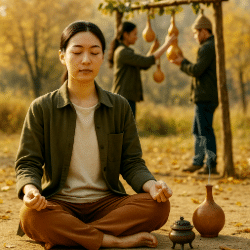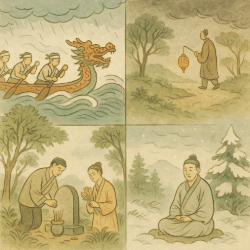Trees have long stood as more than just flora in Taoist thought. They are vessels of qi, witnesses to the rhythms of nature, and anchors of spiritual insight. From mythic trees like Fusang and Jianmu to the camphor-wrapped shrines of Taiwan, Taoist traditions across history and geography have viewed trees as part of a vast flowing harmony between humanity and the natural world.
To fully understand the role of trees in Taoism, it’s important to consider the diversity of Taoist traditions. Major sects like Zhengyi (Celestial Masters), Shangqing (Highest Clarity), and Folk Taoism—as well as modern lineages like 4AS (4 Ascendant Sphere Tradition)—each offer unique interpretations. These sects also span distinct historical periods and geographic regions, shaping how trees are symbolized, honored, and engaged with in practice.
Ancient Symbolism and Mythic Trees
The early Taoist cosmologies speak of sacred trees that connect realms:
Jianmu (建木): Described in texts like Shan Hai Jing, Jianmu connects heaven and earth and symbolizes the ladder of spiritual ascent.
Fusang (扶桑): A mythical mulberry tree where the sun rises, Fusang represents beginnings, vitality, and cosmic direction.
Peach Tree of Immortality: In Queen Mother of the West lore, this tree bears fruit every 3,000 years, granting immortality to the worthy.
These mythic trees serve not just as symbols, but as spiritual metaphors and meditative foci, especially in internal alchemy.
Sectarian Views and Real Practices
Across the centuries, Taoist sects developed distinct relationships with trees, often shaped by geography and ritual lineage.
Zhengyi (Celestial Masters) – Central China, Han to Tang Dynasties onward
Zhengyi Taoism is known for its ritual liturgies and integration with local governance. Zhengyi Taoists perform seasonal rites under ancient trees believed to house local spirits (shen). Red or yellow silk is tied around trunks to honor and invite these presences.
Shangqing (Highest Clarity) – Southern China, 4th century CE onward
Emerging from ecstatic revelatory traditions, Shangqing emphasized visualization, alchemy, and retreat. In meditation, practitioners visualize sacred trees as cosmic ladders. Trees in nature are seen as resonant points for absorbing heavenly qi and grounding spiritual energy.
Folk Taoism – Widespread, rural and urban, past and present
Often practiced outside of monasteries, Folk Taoism includes shrine-based rituals and community observances. In southern China and Taiwan:
Banyan, fig, and camphor trees are especially revered.
Offerings, incense, and prayers are made at tree bases.
Trees that survive lightning, odd growth, or time are seen as spiritual guardians.
The 4AS Perspective: Harmony with the Flowing Field
In the 4AS Taoist lineage, trees are seen not only as spiritual beings but as participants in a greater field of natural harmony. This field is interactive: by being near a tree, breathing with it, or honoring it ritually, humans reattune to the flowing balance of the world. Trees form a kind of silent music, and humans can choose to harmonize with it.
This view parallels other sects but emphasizes a more participatory and living dialogue with the natural world. 4AS teachings tend to focus on experiential engagement rather than liturgical or alchemical form.
Trees in Taoist Alchemy and Medicine
Pine trees are considered sources of longevity qi; practitioners meditate under them to absorb yang essence.
Certain woods are used in talismans and ritual tools.
Tree resins and barks are key ingredients in classical formulas.
Taoist texts sometimes instruct the practitioner to “gather the essence of the east wind under the plum tree” during spring rites.
Geographic Patterns
The importance of specific tree types often reflects regional ecosystems and the character of local Taoist practice:
North China: Pine, cypress, and plum trees dominate sacred mountains like Wudang and Songshan, associated with hermitages and formalized ritual.
South China & Taiwan: Banyan, camphor, and fig trees are seen as sacred due to their sprawling roots and longevity. Community shrines and tree-centered altars are common.
Southeast Asia: Taoist diaspora communities hybridize Chinese views with local traditions, such as reverence for Bodhi trees in Vietnamese and Thai temples.
Modern Applications: Trees in Personal Practice
Many modern practitioners build Taoist gardens or meditation spots around specific trees. Some:
Designate a tree in their yard or a park as a place for daily breathwork.
Wrap trees with red thread during festivals as a symbolic act of connection.
Use tree-dwelling birds and natural cycles as guidance for personal cultivation.
These practices allow individuals to engage with Taoist principles regardless of location or lineage.
Conclusion: Living Roots of the Tao
Whether as mythic archetypes or living companions, trees in Taoism represent continuity, resilience, and connection. Across sects, regions, and centuries, Taoist traditions have looked to trees not only for shelter or beauty, but as spiritual co-participants in the unfolding Dao.
Frequently Asked Questions
Yes. Taoist traditions often regard trees like pine, plum, banyan, and camphor as sacred due to their symbolism, age, or energetic qualities. Some trees are even honored as spirit dwellings.
Jianmu is a mythic tree said to connect Heaven and Earth. It represents spiritual ascent, cosmic alignment, and the bridge between mortal and divine realms.
Yes. From meditating under pine trees to offering incense at shrine trees, Taoists often engage with trees as part of seasonal rituals or daily practice, especially in folk and Zhengyi traditions.
Many designate trees in parks or gardens for personal rituals, wrap red thread as an offering, or use breathwork and stillness to attune to a tree’s natural qi field.



